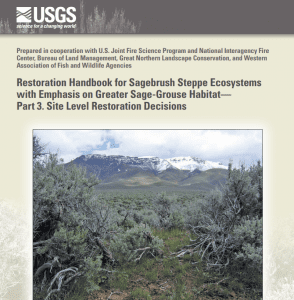Article / Book
View article.
This study used graph theory, representing priority areas as spatially distributed nodes interconnected by movement corridors, to understand the capacity of priority areas to function as connected networks in the Bi-State, Central, and Washington regions of the greater sage-grouse range. The Bi-State and Central networks were highly centralized; the dominant pathways and shortest linkages primarily connected a small number of large and centrally located priority areas. These priority areas are likely strongholds for greater sage-grouse populations and might also function as refugia and sources.
View article.
This study measured aboveground C pools and fluxes at leaf, soil, and ecosystem scales over a single growing season in plots that had 200 mm of supplemental precipitation added in either winter or summer for the past 21 years, in shrub- and exotic-bunchgrass-dominated garden plots. In general, ecosystem C uptake and long-term biomass accumulation were greater in winter- and summer-irrigated plots compared to control plots in both vegetation communities.
View report.
This study adapted and applied four rangeland health indicators to data compiled by the U.S. Department of Agriculture, Forest Service, Rocky Mountain Research Station’s Forest Inventory and Analysis (FIA) program for research locations on the Fishlake National Forest in central Utah. These data can be used by local forest managers to determine the health status of the local forest and to identify the proportion of sites that may be functioning at risk.
View article.
This study used public land records to characterize livestock grazing across Wyoming, USA, and we used greater sage-grouse (Centrocercus urophasianus) as a model organism to evaluate responses to livestock management. The study found grazing can have both positive and negative effects on Sage-grouse populations depending on the timing and level of grazing. Sage-grouse populations responded positively to higher grazing levels after peak vegetation productivity, but populations declined when similar grazing levels occurred earlier, likely reflecting the sensitivity of cool-season grasses to grazing during peak growth periods.
View article.
This study analyzed data sets from previous and ongoing studies across the Great Basin characterizing cover response of perennial and annual forbs that are consumed by sage grouse to mechanical, prescribed fire, and low-disturbance fuel reduction treatments. Annual forbs favored by sage grouse benefited most from prescribed fire treatments with smaller increases following mechanical and fuel reduction treatments.
View handbook.
This handbook walks managers and practitioners through a number of site-specific decisions managers face before selecting the appropriate type of restoration. This site-level decision tool for restoration of sagebrush steppe ecosystems is organized in nine steps.
- Step 1 describes the process of defining site-level restoration objectives.
- Step 2 describes the ecological site characteristics of the restoration site. This covers soil chemistry and texture, soil moisture and temperature regimes, and the vegetation communities the site is capable of supporting.
- Step 3 compares the current vegetation to the plant communities associated with the site State and Transition models.
- Step 4 takes the manager through the process of current land uses and past disturbances that may influence restoration success.
- Step 5 is a brief discussion of how weather before and after treatments may impact restoration success.
- Step 6 addresses restoration treatment types and their potential positive and negative impacts on the ecosystem and on habitats, especially for greater sage-grouse. We discuss when passive restoration options may be sufficient and when active restoration may be necessary to achieve restoration objectives.
- Step 7 addresses decisions regarding post-restoration livestock grazing management.
- Step 8 addresses monitoring of the restoration; we discuss important aspects associated with implementation monitoring as well as effectiveness monitoring.
- Step 9 takes the information learned from monitoring to determine how restoration actions in the future might be adapted to improve restoration success.
Seventy-five years of vegetation treatments on public rangelands in the Great Basin of North America
View article.
This article summarizes information from land treatments occurring over millions of hectares of public rangelands in the Great Basin over the last 75 years represent one of the largest vegetation manipulation and restoration efforts in the world.
View article.
This study found that insects generally reduced the severity of subsequent wildfires. Specific effects varied with insect type and timing, but both insects decreased the abundance of live vegetation susceptible to wildfire at multiple time lags. By dampening subsequent burn severity, native insects could buffer rather than exacerbate fire regime changes expected due to land use and climate change. In light of these findings, the researchers recommend a precautionary approach when designing and implementing forest management policies intended to reduce wildfire hazard and increase resilience to global change.
View synthesis.
This short synthesis highlights findings of the national Fire and Fire Surrogates Study, which conducted an integrated network of experiments at 13 sites across the United States, many of which took place on National Forest lands. Results suggest that more species increased in number than decreased. For example, researchers reported that populations of western bluebirds (Sialia mexicana) increased following prescribed fire; whereas mountain chickadees (Poecile gambeli) decreased in response to thinning treatments. The positive and negative responses of deer mice (Peromyscus maniculatus), gray-collared chipmunks (Tamias cinereicollis) and least chipmunks (T. minimus) varied among the sites; but the overall biomass of small mammals increased in response to the fire treatments. Researchers also found that small mammals’ responses were related to fire uniformity: the more heterogeneous the post-fire landscape, the greater the proportion of positive responses.


